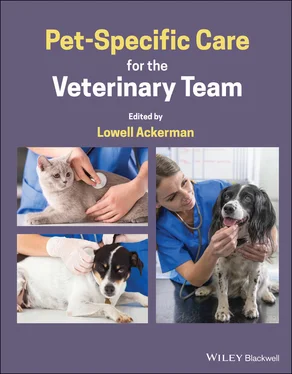Pet‐specific care involves approaches that allow predictions to be made as to an individual's susceptibility to disease, its possible prevention, prospects for early detection, the course of that disease, and the disease's likely response to treatment.
The goal of pet‐specific care is to prevent disease, if at all possible, or to decrease the impact of the disease on the patient, thereby improving the pet's quality of life. This is typically accomplished by identifying risk factors so that veterinary teams and pet owners can be proactive in instituting lifestyle modifications and increased veterinary surveillance so that problems can be detected at the earliest opportunity, hopefully while they are still subclinical, and when there are typically the most options available for successful management.
Pet‐specific care is also known by several other terms, including:
Personalized medicine
Precision medicine
Pet‐centric care
Client‐centric care
Lifelong care
Theranostics
Stratified medicine
Predictive medicine
Patient‐specific medicine
P4 medicine
Genomic medicine
Individualized medicine.
1.1.3 Why Pet‐Specific Care?
The fundamental premise of pet‐specific care is that each pet has unique attributes (genetic and otherwise) that make them susceptible to health issues and that by better understanding this uniqueness, we can more specifically tailor care to the needs of the specific pet and owner. At the present time, most of the research has focused on being able to predict susceptibility to disease, but the potential exists to also predict which medical treatments are most likely to be safe and effective, and which are best avoided in an individual. It might even be possible to predict which diets would be most appropriate for specific pets.
Pet‐specific care has the potential to change the way we consider, identify, and approach medical management issues and it can not only streamline evidence‐based care, but can help us minimize harmful side effects, ensure more beneficial outcomes, and even help clients save money on their veterinary care by avoiding processes less likely to be successful.
In the current veterinary business model, most veterinary practices engage in routine examinations, vaccinations, and parasite control, but otherwise assume a reactive posture to healthcare issues, waiting for the onset of clinical disease before intervening. Once a clinical disease condition is recognized, the prudent approach would be to recommend an evidence‐based approach to management (see 2.1Evidence‐Based Veterinary Medicine and Personal Bias) with facilitated compliance, but in many hospitals, the approach, even for very basic conditions, is left up to the individual clinician. The problem with this approach is that veterinary businesses like to tout the exceptional level of care they provide to their clients, but without consistency of care (see 9.8Ensuring Consistency of Care), there can be no assurance to clients about the level of care provided; it will vary based on the experience and expertise of each individual veterinarian in the practice.
Pet‐specific care adopts a more comprehensive approach to the situation, concentrating preferentially on health management, risk assessment, prevention, early detection, appropriate treatment, facilitated compliance and then patient management over the long term (concentrating on healthspan rather than lifespan).
Let's illustrate this philosophy with a common example – osteoarthritis. Most veterinarians diagnose osteoarthritis when a pet has lameness or displays discomfort when getting up or lying down. Diagnostic testing at this stage may indicate fairly advanced osteoarthritis evident on radiography. We might be content that we have correctly diagnosed the problem, but our human physician counterparts would likely consider this a Pyrrhic victory – their goal would have been to identify the problem much earlier and seek to change the course of the disease process, preferably so the individual never goes on to have chronic pain and mobility issues. At that point, the physician would make recommendations according to accepted guidelines, and if the patient was not responding as anticipated, would refer the patient to a specialist in a systematic fashion.
Could we do a better job in veterinary medicine? Absolutely! The first step is to create a risk profile for each individual pet during puppy and kitten visits, using information at our disposal but that often does not get the attention it deserves (see 2.7Risk Assessment). For example, while osteoarthritis can be recognized in virtually any dog or cat, there are many breeds that have a higher prevalence of the condition, and underlying conditions that increase risk, so such pets should have screening to identify cases earlier, hopefully when they are subclinical and we have the most options for changing the trajectory of the disorder.
Are there other situations that should make us more vigilant for the increased probability of osteoarthritis in our clinic populations? Yes! In addition to underlying problems that may be heritable (such as hip dysplasia), pets with prior history of trauma, those with co‐morbidities that may predispose to osteoarthritis and even those with weight management issues may be at increased risk and would benefit from early screening. These risk factors should prompt us to evaluate for osteoarthritis earlier and more consistently, but since all pets can develop osteoarthritis, and it usually presents in young adult to middle‐aged pets, routine screening should also be done for all pets earlier than typical profiles that get initiated in senior patients.
Interestingly, pet‐specific care is about much more than just medical competence, since it also impacts customer satisfaction and retention. It should not be surprising that pet owners actually expect this level of care from veterinary teams, and believe they are already paying for this level of excellence. Consider for a moment the pet owner who dutifully brings in their pet for evaluation and pays for that visit. Is it fair that they expect the veterinary team they are entrusting with their pet's care to actually know the problems to which their pet is prone, and act accordingly? Is it fair that the pet owner of a Cavalier King Charles spaniel expects the veterinary team to know that their pet is prone to a variety of ills, including mitral valve disease, keratoconjunctivitis sicca, macrothrombocytopenia, primary secretory otitis media, and syringomyelia (among others), and that the veterinary team is prepared to counsel and assess accordingly (see 11.4Heritable Health Conditions – by Breed)? While most veterinary practices will admit that they are not actually providing this level of service, most will reluctantly acknowledge that it is fair for paying clients to expect it. It is a commitment to pet‐specific care that creates the framework in which this can happen consistently.
Similarly, is it reasonable for clients to expect that the veterinary team will take every precaution to determine if certain drugs could cause adverse effects in their individual pet (toxgnostics) or know that a pet that travels with its owners warrants different preventive care strategies, or that pets that engage in specific activities might have altered risk profiles? In the future, we will also likely be able to engage in what is currently being referred to as companion diagnostics, which is a way to test safety and efficacy of a drug specific to a target patient group, breed, or otherwise identified individual (biomarkers, genetic markers, etc.). So, there may come a time when we are able to screen individuals at risk (for example, for potential idiosyncratic reactions such as to nonsteroidal antiinflammatory drugs). We just need a system in place to take advantage of these developments, and pet‐specific care can be that system.
Читать дальше












